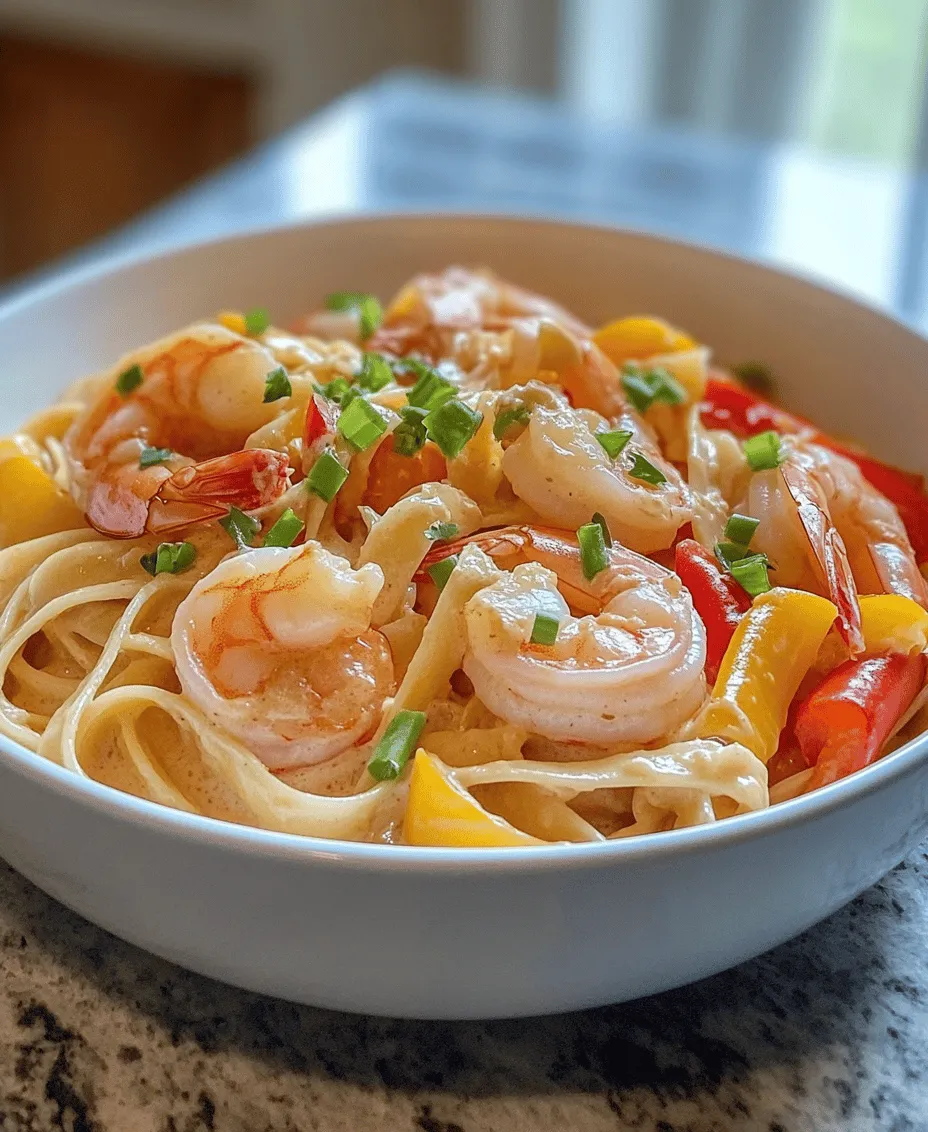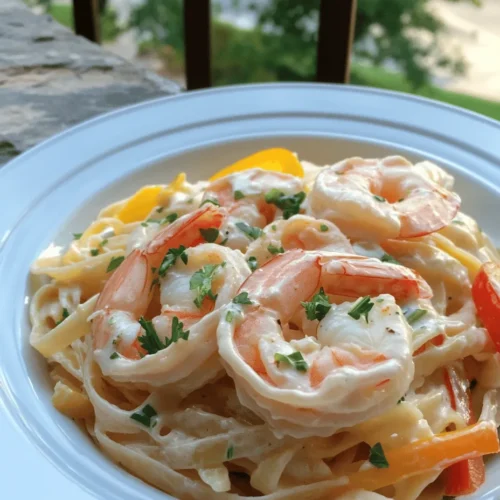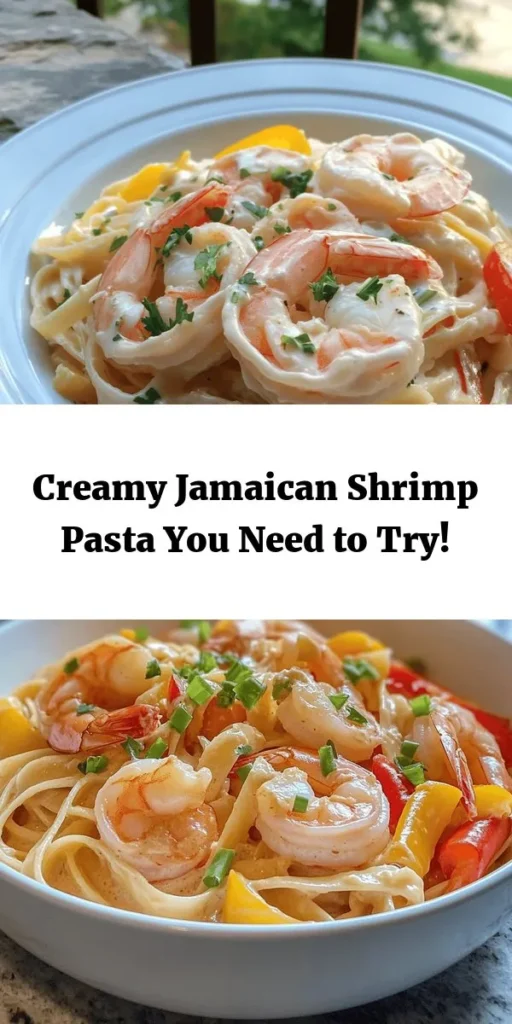Introduction
Jamaican cuisine is renowned for its vibrant flavors and unique combinations, and this Jamaican Shrimp Pasta recipe is no exception. With its rich blend of spices, fresh seafood, and creamy textures, this dish offers a delightful culinary experience that transports your taste buds straight to the Caribbean. Imagine the warm sun, gentle breezes, and the sound of waves lapping against the shore as you savor each bite of this delectable meal. Whether you are hosting an extravagant dinner party or simply looking for a quick yet impressive weeknight meal, this recipe is sure to become a favorite in your household.
In this article, we will delve into the origins of Jamaican Shrimp Pasta, explore the key ingredients that make this dish so special, and provide detailed cooking instructions to guide you through the process. Additionally, we will share tips that will help you perfect this creamy delight, ensuring that each serving is bursting with flavor and authenticity.
The Allure of Jamaican Cuisine
Exploring the Rich Tapestry of Flavors
Jamaican cuisine is a fascinating fusion of various culinary traditions, influenced by the island’s rich history and diverse cultural heritage. The island’s food reflects a blend of African, European, Indian, and Chinese flavors, resulting in a vibrant tapestry of tastes and textures. This unique culinary amalgamation has given rise to iconic dishes, such as jerk chicken, ackee and saltfish, and, of course, the irresistible Jamaican Shrimp Pasta.
At the heart of Jamaican cooking are key ingredients that create the robust flavors characteristic of the island. Spices such as allspice, thyme, and Scotch bonnet peppers are staples, adding depth and heat to many dishes. Fresh seafood, particularly shrimp, is abundant and often featured prominently, reflecting Jamaica’s coastal geography. The use of coconut milk and tropical fruits further enhances the island’s culinary offerings, bringing a creamy and refreshing element to various recipes.
Key Ingredients Commonly Used in Jamaican Dishes
When exploring Jamaican dishes, you’ll encounter a diverse array of ingredients that are essential to their unique flavor profiles. Here are some common components:
– Spices and Herbs: Allspice, thyme, and scallions are frequently used to season meats and seafood, providing a signature Caribbean taste.
– Proteins: Seafood, particularly shrimp, fish, and jerk-seasoned chicken, plays a major role, highlighting the island’s access to fresh ingredients.
– Vegetables: Bell peppers, onions, and carrots are often included to add color and sweetness to dishes, creating a balanced flavor.
– Coconut Products: Coconut milk and grated coconut are utilized for their creamy texture and tropical flair, lending richness to both savory and sweet dishes.
The Influence of Various Cultures on Jamaican Cooking
The culinary landscape of Jamaica is a result of centuries of influence from various cultures. The African population, which forms a significant part of the island’s heritage, brought traditional cooking techniques, spices, and a love for bold flavors. European settlers introduced new ingredients and cooking methods, while Indian and Chinese immigrants contributed their unique spices and dishes. This cultural melting pot has resulted in a vibrant cuisine that reflects Jamaica’s history and traditions.
Among these cultural influences, the fusion of flavors can be notably observed in the Jamaican Shrimp Pasta recipe. The combination of Italian pasta with Jamaican spices and the freshness of shrimp showcases the versatility of Jamaican cuisine and its ability to adapt and integrate diverse culinary elements.
Ingredients Breakdown
A Closer Look at Each Component
To create a truly delicious Jamaican Shrimp Pasta, it’s essential to understand the role of each ingredient in the dish. Let’s break down the components that come together to create this creamy delight:
Fettuccine Pasta: The Perfect Base
Fettuccine pasta serves as the ideal base for this dish, providing a hearty and satisfying texture that complements the creamy sauce. Its flat, ribbon-like shape allows it to hold onto the sauce beautifully, ensuring that every bite is filled with flavor. You can choose between fresh or dried fettuccine, depending on your preference and availability.
Shrimp: Selecting Fresh vs. Frozen
Shrimp is the star of this dish, bringing a sweet and succulent taste that pairs perfectly with the creamy sauce. When selecting shrimp, freshness is key. If possible, opt for fresh shrimp from your local fish market, ensuring they are firm and have a mild ocean scent. If fresh shrimp is unavailable, frozen shrimp is a suitable alternative. When using frozen shrimp, make sure to thaw them properly before cooking to achieve the best texture and taste.
Aromatics: Garlic and Onion for Flavor Depth
Aromatics like garlic and onion are essential for building layers of flavor in this dish. Sautéing minced garlic and diced onion in oil helps release their natural sweetness and enhances the overall taste of the pasta. The combination of these aromatics creates a fragrant base that sets the stage for the other ingredients to shine.
Peppers: Adding Color and Sweetness
Bell peppers not only add vibrant color to the dish but also provide a subtle sweetness that balances the spiciness of the other ingredients. A mix of red and green bell peppers works well, offering visual appeal and a delightful crunch. When sautéed, the peppers soften and meld beautifully with the other components, enriching the dish’s overall flavor.
Spices: The Essence of Jamaican Flavor
No Jamaican dish is complete without a medley of spices that define its unique character. In this recipe, we will incorporate spices such as allspice, thyme, and Scotch bonnet pepper. Allspice adds warmth and depth, while thyme contributes a fresh, herbal note. If you enjoy a bit of heat, a small amount of Scotch bonnet pepper will elevate the dish, but be cautious with the quantity, as it can be quite spicy.
Coconut Milk: Creamy Texture with Tropical Flair
Coconut milk is a quintessential ingredient in Jamaican cuisine, known for its creamy texture and tropical sweetness. In this recipe, coconut milk serves as the base for the sauce, providing a velvety richness that complements the shrimp and pasta. It also adds a subtle coconut flavor that enhances the overall dish.
Heavy Cream and Parmesan: Enhancing Richness
To elevate the creaminess of the sauce, heavy cream is added alongside coconut milk. This combination results in an indulgent, rich sauce that clings beautifully to the pasta. Additionally, freshly grated Parmesan cheese contributes a savory element, enhancing the overall flavor profile and providing an added layer of creaminess.
The Role of Garnishes: Green Onions and Parsley
Garnishes play an important role in the presentation and flavor of the dish. Chopped green onions add a pop of color and a mild onion flavor, while freshly chopped parsley brings a fresh, herbaceous note that brightens the plate. These garnishes not only enhance the visual appeal of the dish but also provide a final touch of flavor that rounds out the meal.
Cooking Preparation
Setting Up for Success
Before diving into the cooking process, it’s crucial to prepare your kitchen and ingredients for a smooth and enjoyable cooking experience. This preparation phase, often referred to as mise en place, ensures that you have everything at your fingertips, allowing you to focus on creating a delicious dish without unnecessary interruptions.
Essential Kitchen Tools and Equipment Needed
For this Jamaican Shrimp Pasta recipe, you’ll need the following kitchen tools and equipment:
– A large pot for boiling the fettuccine
– A large skillet or frying pan for sautéing the shrimp and sauce
– A cutting board and sharp knife for chopping vegetables and aromatics
– Measuring cups and spoons for accurate ingredient measurements
– A wooden spoon or spatula for stirring
– A colander for draining the pasta
Preparing Ingredients: Chopping, Measuring, and Organizing
Begin by gathering all your ingredients and tools. This step will save you time and effort during the cooking process. Chop the garlic and onion, slice the bell peppers, and measure out the spices and liquids. Having everything ready to go will help streamline the cooking process and ensure that you don’t miss any crucial steps.
The Importance of Mise en Place in Cooking
Mise en place, a French culinary term meaning “everything in its place,” is an essential principle in cooking. It involves organizing and preparing all ingredients before you start cooking. This technique not only makes the cooking process more efficient but also minimizes the risk of forgetting an ingredient or step. By taking the time to prepare your ingredients beforehand, you set yourself up for success, allowing you to focus on creating a delicious Jamaican Shrimp Pasta without any distractions.
Step-by-Step Cooking Instructions
With your ingredients prepped and your kitchen organized, you are now ready to embark on the cooking journey. Follow these step-by-step instructions to create your own Jamaican Shrimp Pasta masterpiece, where each step builds on the last to create a flavorful and satisfying dish.
1. Cook the Fettuccine: Begin by bringing a large pot of salted water to a boil. Add the fettuccine and cook according to the package instructions until al dente. Once cooked, reserve about a cup of the pasta water, then drain the fettuccine in a colander and set aside.
2. Sauté the Aromatics: In a large skillet, heat a tablespoon of olive oil over medium heat. Add the minced garlic and diced onion, sautéing for 2-3 minutes until they become fragrant and translucent.
3. Add the Bell Peppers: Toss in the sliced bell peppers and continue sautéing for another 3-4 minutes until they soften slightly and their colors brighten.
4. Cook the Shrimp: Increase the heat to medium-high and add the shrimp to the skillet. Season with salt, pepper, and your chosen spices (allspice, thyme, and Scotch bonnet pepper). Cook the shrimp for about 2-3 minutes per side, or until they turn pink and opaque.
5. Create the Creamy Sauce: Lower the heat to medium and pour in the coconut milk and heavy cream. Stir to combine, allowing the mixture to simmer gently for a few minutes. If the sauce is too thick, gradually add some reserved pasta water until you reach the desired consistency.
6. Combine with Pasta: Add the cooked fettuccine to the skillet, tossing gently to coat the pasta evenly with the creamy sauce. If needed, adjust the seasoning with salt and pepper to taste.
7. Finish with Parmesan: Stir in the grated Parmesan cheese, allowing it to melt into the sauce and enhance the creaminess.
8. Garnish and Serve: Remove the skillet from the heat and garnish the pasta with chopped green onions and parsley. Serve immediately, savoring the delightful fusion of flavors.
With these steps, you will be well on your way to creating a mouthwatering Jamaican Shrimp Pasta that celebrates the rich flavors of Jamaican cuisine. Stay tuned for the next section, where we will share expert tips to ensure your dish is nothing short of perfection.

Bringing the Dish to Life
Cooking the Fettuccine: Achieving the Perfect Al Dente
To begin crafting your Jamaican Shrimp Pasta, focus on the fettuccine. Start by bringing a large pot of salted water to a rolling boil. The salt not only enhances the pasta’s flavor but also helps to prevent it from becoming mushy. Once the water is boiling, add the fettuccine and stir gently to prevent sticking. For the best results, refer to the package instructions for cooking time, typically around 8-10 minutes. To achieve that perfect al dente texture, taste the pasta a minute or two before the suggested cooking time ends. The pasta should be firm but not hard, providing a satisfying bite when you enjoy it with the shrimp and sauce.
Once the fettuccine is al dente, reserve about a cup of the pasta water (it’s starchy and can help adjust your sauce later) before draining the pasta in a colander. Rinse it briefly under cool water if you’re not adding it to the sauce immediately, as this helps to prevent sticking.
Sautéing the Shrimp: Key Techniques for Flavor and Texture
While the fettuccine is cooking, turn your attention to the shrimp. In a large skillet, heat 2 tablespoons of olive oil over medium-high heat. Once the oil is hot, add the shrimp in a single layer, ensuring they have space to cook evenly. Avoid overcrowding the pan, as this can cause the shrimp to steam rather than sauté.
Sprinkle the shrimp with salt, pepper, and your choice of Jamaican spices—such as allspice or jerk seasoning—for that authentic flavor. Cook the shrimp for 2-3 minutes on one side until they turn pink and opaque. Then, flip them over and cook for an additional minute. The shrimp should be perfectly tender and slightly caramelized on the edges. Remove the shrimp from the skillet and set them aside, keeping the flavorful remnants in the pan for the next step.
Creating the Creamy Sauce: Balancing Ingredients for the Best Flavor
With the shrimp sautéed, it’s time to create the creamy sauce that will bind the dish together. In the same skillet (do not clean it!), reduce the heat to medium and add 1 cup of heavy cream to the pan. As the cream begins to simmer, scrape up the flavorful bits left from the shrimp to incorporate those rich flavors into your sauce.
Next, add in 1 cup of grated Parmesan cheese, stirring continuously until it melts into the cream, creating a luscious sauce. For a hint of brightness, squeeze in the juice of half a lime and add a tablespoon of chopped fresh parsley. This will not only enhance the flavor but also add a refreshing note to balance the richness of the cream.
If the sauce seems too thick, gradually add some of the reserved pasta water until you reach your desired consistency. Taste and adjust the seasoning with more salt, pepper, or spices as needed.
Combining Ingredients: Ensuring Every Bite is Delicious
Once your sauce is ready, it’s time to combine all components. Add the drained fettuccine directly into the skillet with the creamy sauce, tossing gently to coat the pasta evenly. Then, add the sautéed shrimp back into the pan, stirring to incorporate everything together. This ensures that every bite is infused with the rich flavors of the sauce and shrimp.
If you prefer a bit of heat, consider adding a pinch of crushed red pepper flakes at this stage. Also, don’t forget to fold in some fresh spinach or cherry tomatoes for added color and nutrients. Allow everything to simmer together for another minute or two so that the flavors meld beautifully.
Final Touches: Presentation and Garnishing Tips
Before serving, it’s essential to make your dish visually appealing. Plate the Jamaican Shrimp Pasta by twirling the fettuccine onto each plate and topping it generously with shrimp and sauce. To elevate the presentation, garnish with additional chopped parsley or a sprinkle of freshly grated Parmesan cheese. A lime wedge on the side not only looks great but offers a zesty burst of flavor to enhance each bite.
Flavor Profile
Understanding the Harmony of Ingredients
The beauty of Jamaican Shrimp Pasta lies in its harmonious blend of flavors. The spices used to season the shrimp—such as allspice and jerk seasoning—offer a warm, aromatic profile that complements the natural sweetness of the shrimp. The creaminess of the sauce provides a rich backdrop, balancing out the spices while adding a luxurious texture.
Fresh herbs, particularly parsley and lime, play a crucial role in elevating the overall taste. They add brightness and freshness, cutting through the richness of the dish and enhancing the various flavors. This interplay of creamy and spicy results in a well-rounded dish that is both indulgent and vibrant.
Nutritional Information
Balancing Indulgence with Nutrition
Jamaican Shrimp Pasta is not only delicious but also nutritious. Shrimp is a low-calorie protein source, rich in essential nutrients like selenium and vitamin B12. A typical serving of this dish contains approximately 500-600 calories, with about 20-25 grams of protein, depending on serving size and specific ingredients used.
To make the dish healthier, consider the following suggestions:
– Swap heavy cream for a lighter version, such as half-and-half or a plant-based cream alternative.
– Use whole wheat fettuccine for added fiber and nutrients.
– Increase the proportion of vegetables, such as spinach, bell peppers, or zucchini, to boost the dish’s nutritional profile without significantly increasing calories.
Serving Suggestions
Enhancing Your Meal Experience
To make your Jamaican Shrimp Pasta an unforgettable meal, consider these serving suggestions:
– Ideal Pairings: Serve the pasta with a light, citrusy salad to complement the dish’s richness. A simple mixed greens salad with a vinaigrette dressing is a perfect choice.
– Side Dishes: Grilled vegetables or roasted asparagus can add a delightful crunch and additional flavors that harmonize with the pasta.
– Beverage Recommendations: Pair your meal with a refreshing white wine, such as Sauvignon Blanc, which complements the shrimp’s sweetness. Alternatively, a tropical drink like a mango smoothie or a light lager can enhance the Caribbean vibe.
Conclusion
In conclusion, Jamaican Shrimp Pasta is not just a meal; it’s a celebration of the rich, vibrant flavors of Jamaican cuisine. With each bite, you experience the fragrant spices, the creamy texture of the sauce, and the succulent shrimp that make this dish a standout. Whether you’re an experienced chef or a novice in the kitchen, this recipe is accessible and offers a delightful journey into the fusion of cultures. Gather your ingredients, follow the steps, and savor the joy of sharing this truly delicious meal with family and friends. Enjoy the culinary adventure that awaits you with every forkful of Jamaican Shrimp Pasta!



